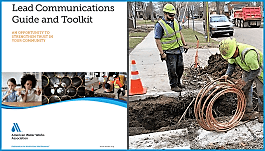New AWWA guide helps water utilities navigate upcoming lead requirements
December 1, 2022

AWWA Articles
New AWWA guide helps water utilities navigate upcoming lead requirements
 A new communications guide to help water utilities navigate the latest regulations concerning lead in drinking water — in particular the U.S. Environmental Protection Agency’s (EPA) revised Lead and Copper Rule (LCRR) — has been developed by top water sector professionals and is now available on the American Water Works Association’s (AWWA) website.
A new communications guide to help water utilities navigate the latest regulations concerning lead in drinking water — in particular the U.S. Environmental Protection Agency’s (EPA) revised Lead and Copper Rule (LCRR) — has been developed by top water sector professionals and is now available on the American Water Works Association’s (AWWA) website.
The Lead Communications Guide and Toolkit draws on insights and examples from utilities throughout the United States and Canada. It was developed by a project committee of AWWA members from the Public Affairs and Water Utility councils with contractor HDR Engineering. An overview of the guide is being presented today, 11 a.m. to 12:30 p.m. MST, during an AWWA webinar, Let’s Talk Lead: New LCRR Communications Tools to Strengthen Public Trust.
 “The LCRR, which goes into effect in October 2024, presents utilities with new challenges, but fundamentally, it presents an opportunity to strengthen public trust,” said Kelley Dearing Smith, chair of the Public Affairs Council.
“The LCRR, which goes into effect in October 2024, presents utilities with new challenges, but fundamentally, it presents an opportunity to strengthen public trust,” said Kelley Dearing Smith, chair of the Public Affairs Council.
“Consumers need to hear from us and hear the story of drinking water and what we do to minimize the risk of lead getting into drinking water,” she added. “Regardless of whether your utility has a dedicated communications department, we all have the responsibility to engage with our communities proactively and on an ongoing basis. The Lead Communications Guide provides strategies and examples of how utilities can build positive and transparent relationships with their communities and become a trustworthy source of information.”
Included in the guide are sections covering:
- Best practices for communications, including examples and guidance
- Tips for communicating about water quality with the public and community members
- Regulatory requirements and what they mean for a utility’s communication and outreach efforts
- Checklists for meeting key LCRR communication and outreach requirements and assessing a utility’s readiness for implementation
 “Every utility – small, medium and large – needs to begin now to prepare for new requirements such as lead service line inventories, required customer communications, and water sampling at schools and licensed childcare facilities,” said Alexis Woodrow, the Water Utility Council’s representative on the project committee. “Effective communications with consumers will be critical to a utility’s success in managing these requirements.”
“Every utility – small, medium and large – needs to begin now to prepare for new requirements such as lead service line inventories, required customer communications, and water sampling at schools and licensed childcare facilities,” said Alexis Woodrow, the Water Utility Council’s representative on the project committee. “Effective communications with consumers will be critical to a utility’s success in managing these requirements.”
The guide was developed to help water systems prepare for requirements in the LCRR, and for additional considerations in the forthcoming Lead and Copper Rule Improvements (LCRI).
The LCRR went into effect in December 2021 to support near-term development of U.S. regulatory actions to reduce lead in drinking water – including the identification, mapping, and removal of lead service lines. At the same time, EPA said it would develop a new proposed rulemaking to strengthen key elements of the rule – the LCRI. The agency anticipates finalizing the LCRI prior to Oct. 16, 2024, the initial compliance date in the LCRR.
Advertisement